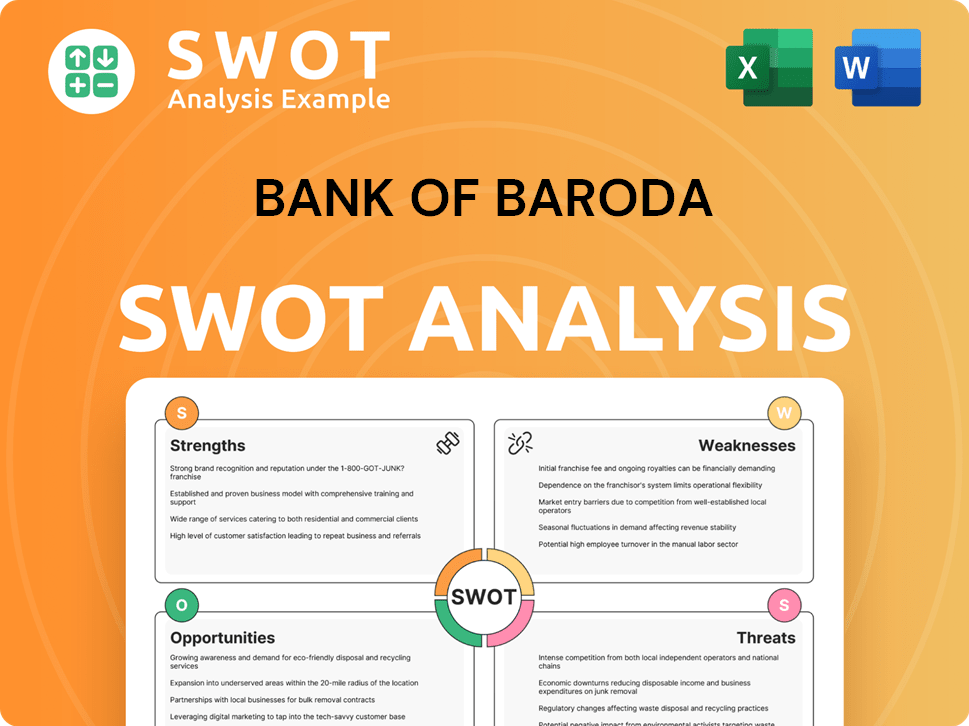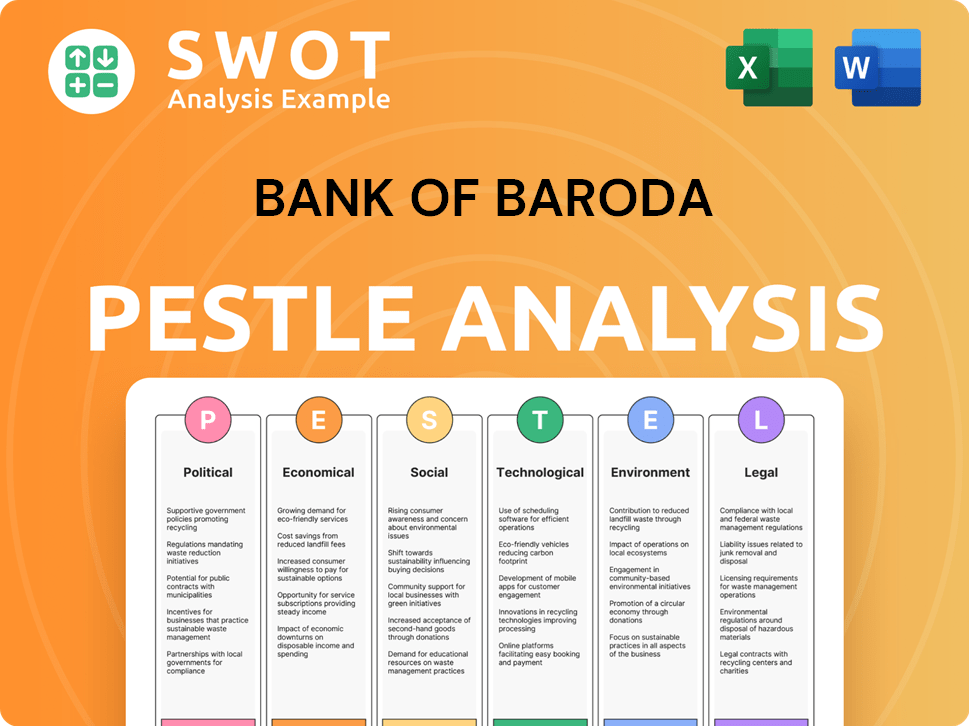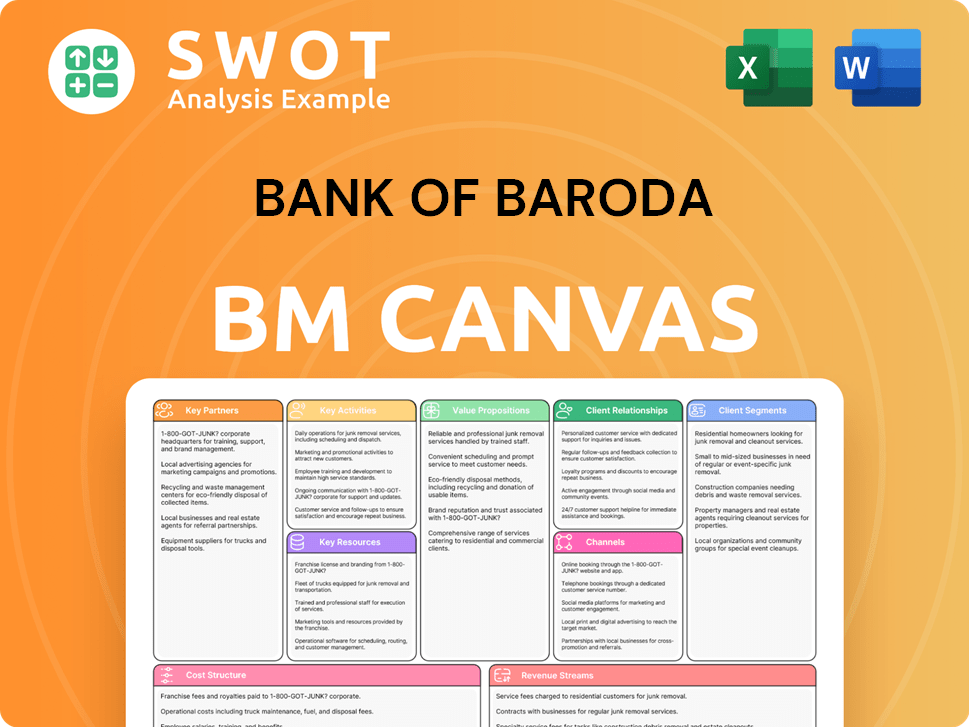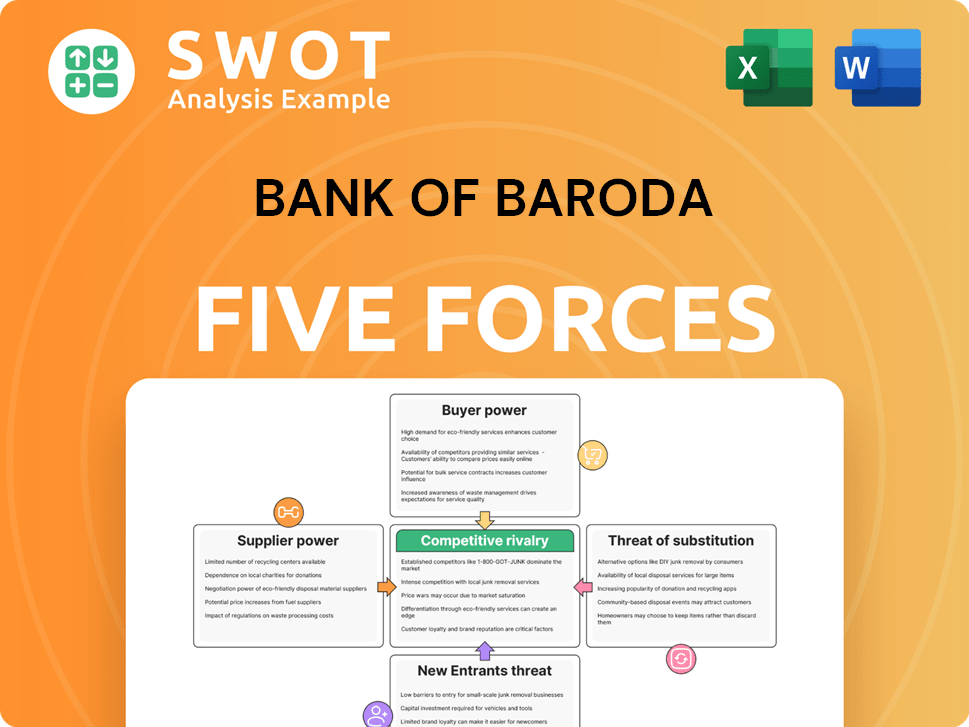Bank of Baroda Bundle
How Does Bank of Baroda Stack Up in India's Banking Battleground?
Bank of Baroda, a cornerstone of the Indian banking sector since 1908, navigates a fiercely competitive environment. Its journey from a princely state's vision to a leading financial institution is a testament to its resilience. Understanding the Bank of Baroda SWOT Analysis is key to grasping its strategic positioning in the market.

This exploration of the Bank of Baroda competitive landscape will dissect its strategies within the Indian banking sector, focusing on its key competitors and market dynamics. We'll analyze the bank's position, considering factors like its market share analysis, financial performance, and competitive advantages. By examining the impact of banking industry competition, we aim to provide a comprehensive market analysis of BoB and its rivals.
Where Does Bank of Baroda’ Stand in the Current Market?
Bank of Baroda (BoB) holds a significant market position within the Indian banking sector, ranking among the top public sector banks. As of March 2024, BoB reported a total business (deposits plus advances) exceeding ₹22.54 lakh crore, demonstrating its substantial scale and reach in the market. This positions BoB as a key player in the Indian banking sector, with a broad customer base and extensive operational footprint.
BoB's core operations encompass a wide range of financial services. These include retail banking services like savings accounts, loans, and credit cards, along with corporate banking solutions such as working capital and project finance. BoB also provides international banking services for non-resident Indians (NRIs) and cross-border transactions, as well as treasury services to manage investments and foreign exchange. The bank's diverse product offerings and extensive service portfolio cater to a broad spectrum of customer needs, from individual consumers to large corporations.
The value proposition of BoB lies in its extensive network, diverse product offerings, and commitment to digital transformation. With over 8,200 branches and more than 10,000 ATMs across India as of March 2024, BoB ensures deep penetration into both urban and rural areas. Its international presence in 17 countries further enhances its reach. By focusing on digital platforms and mobile-first strategies, BoB aims to improve customer experience and operational efficiency, providing convenient and accessible banking services.
BoB maintains a substantial market share in both deposits and advances, particularly within the public sector banking segment. This strong market position is supported by its extensive branch network and diverse product offerings. BoB's ability to attract and retain customers is crucial to its competitive standing.
In Q4 FY24, BoB reported a Net Interest Income (NII) of ₹11,793 crore, marking a 2.3% year-on-year growth. The bank's Net Profit for the same period was ₹4,886 crore, demonstrating its profitability and financial stability. These financial results reflect BoB's effective management of its assets and liabilities, contributing to its overall competitive advantage.
BoB has a widespread presence across India with over 8,200 branches and over 10,000 ATMs as of March 2024, ensuring deep penetration into both urban and rural areas. Globally, it operates in 17 countries, with a significant presence in key international financial hubs. This extensive network supports its diverse customer base and international operations.
BoB has strategically emphasized digital transformation, investing in technology to enhance customer experience and operational efficiency. This includes launching digital platforms for various banking services and focusing on mobile-first strategies. This focus on digital banking helps BoB stay competitive in a rapidly evolving market.
BoB faces intense competition from both public and private sector banks. Key competitors include State Bank of India (SBI), HDFC Bank, and ICICI Bank. The competitive landscape is characterized by aggressive pricing, innovative product offerings, and a strong emphasis on digital banking. Understanding the competitive landscape is crucial for BoB's strategic planning.
- Public Sector Banks: SBI, Canara Bank, and Punjab National Bank.
- Private Sector Banks: HDFC Bank, ICICI Bank, Axis Bank, and Kotak Mahindra Bank.
- Foreign Banks: Citibank and Standard Chartered Bank.
- Digital Banks and Fintech Companies: These are emerging competitors, particularly in digital banking services.
In the context of the Indian banking sector, understanding the competitive landscape is crucial for BoB's strategic planning and future growth. For an in-depth look at BoB's business model and revenue streams, you can explore the insights provided in Revenue Streams & Business Model of Bank of Baroda.
Bank of Baroda SWOT Analysis
- Complete SWOT Breakdown
- Fully Customizable
- Editable in Excel & Word
- Professional Formatting
- Investor-Ready Format

Who Are the Main Competitors Challenging Bank of Baroda?
The Bank of Baroda competitive landscape is characterized by intense rivalry within the Indian banking sector. This competition stems from a mix of public sector banks, private sector banks, and emerging fintech companies, all vying for market share and customer loyalty. A thorough BoB market analysis reveals the multifaceted challenges and opportunities the bank faces in this dynamic environment.
Understanding Bank of Baroda's competitors is crucial for assessing its strategic position and future prospects. The bank must continually adapt to the evolving demands of the market, leveraging its strengths while mitigating its weaknesses to maintain a competitive edge. This includes embracing digital transformation, enhancing customer service, and developing innovative financial products.
The Indian banking sector is highly competitive, and Bank of Baroda faces significant challenges from various players. Analyzing the competitive dynamics is essential for understanding the bank's strategic positioning and future prospects. This analysis considers both traditional and emerging competitors, highlighting the strategies employed by each.
Bank of Baroda competes directly with other large public sector banks. These banks often have extensive branch networks and a large customer base.
Key competitors include State Bank of India (SBI), Punjab National Bank (PNB), and Canara Bank.
SBI is the largest bank in India, presenting a formidable challenge due to its expansive network and diverse offerings.
SBI often leads in market share across various segments, including retail and corporate banking. In fiscal year 2024, SBI reported a net profit of approximately ₹61,077 crore.
PNB and Canara Bank compete strongly, particularly in retail and SME lending.
They leverage their extensive branch networks and long-standing customer relationships. In fiscal year 2024, Canara Bank's net profit was reported at ₹14,554 crore.
Private sector banks present significant competition due to their technological advancements and customer-centric approaches.
Key rivals include HDFC Bank, ICICI Bank, and Axis Bank.
HDFC Bank is known for its digital banking prowess and innovative product offerings. It consistently leads in digital banking adoption and credit card issuance.
HDFC Bank's net profit for fiscal year 2024 was approximately ₹60,612 crore.
ICICI Bank and Axis Bank compete fiercely in retail loans, wealth management, and corporate banking.
They often employ competitive pricing and tailored solutions. ICICI Bank reported a net profit of ₹35,946 crore in fiscal year 2024.
The banking industry competition is also influenced by fintech companies and payment banks, which are reshaping the traditional banking model. Entities like Paytm Payments Bank and Airtel Payments Bank are offering niche services and digital experiences, particularly to underserved segments. Recent mergers and alliances within the public sector banking space have also intensified competition, leading to fewer but larger public sector entities. For a deeper dive, you can find more information about the bank's performance and strategies in this detailed article about Bank of Baroda.
Bank of Baroda's competitive advantages include its extensive branch network and established customer base, allowing it to compete effectively in various segments.
The bank's ability to adapt to digital transformation and customer preferences is crucial for maintaining its market position.
- Digital Banking: The rise of digital banking platforms challenges traditional banks to enhance their online and mobile services.
- Customer Service: Superior customer service is a key differentiator, with private sector banks often setting the standard.
- Product Innovation: Offering innovative financial products and services, such as tailored loan products and wealth management solutions, is critical for attracting and retaining customers.
- Mergers and Acquisitions: The consolidation in the banking sector, including mergers and acquisitions, impacts the competitive landscape, creating larger entities with greater resources.
Bank of Baroda PESTLE Analysis
- Covers All 6 PESTLE Categories
- No Research Needed – Save Hours of Work
- Built by Experts, Trusted by Consultants
- Instant Download, Ready to Use
- 100% Editable, Fully Customizable

What Gives Bank of Baroda a Competitive Edge Over Its Rivals?
The competitive landscape for Bank of Baroda (BoB) in the Indian banking sector is shaped by its extensive network and diverse customer base. BoB's strategic moves and competitive edge are defined by its public sector backing and investments in digital transformation. Understanding the Bank of Baroda competitive landscape involves analyzing its strengths, weaknesses, and how it stacks up against its Bank of Baroda competitors.
BoB market analysis reveals that its long-standing presence and customer trust are significant advantages. However, the banking industry competition in India is fierce, with both public and private sector banks vying for market share. The bank's focus on digital innovation, such as the 'bob World' platform, is crucial for staying competitive in the evolving Indian banking sector.
BoB's competitive advantages include its wide branch network, which provides deep reach, especially in semi-urban and rural areas, and a large, loyal customer base built over more than a century. The bank's status as a public sector bank instills customer trust and confidence. BoB benefits from economies of scale, allowing it to offer competitive rates and manage operational costs efficiently. For more insights, consider exploring the Marketing Strategy of Bank of Baroda.
BoB has over 8,200 branches across India, ensuring widespread accessibility. This extensive network is a key differentiator, particularly in regions where private banks have limited penetration. BoB's physical presence supports strong customer loyalty and deposit growth.
As a public sector bank, BoB benefits from a high degree of customer trust and perceived stability. This backing attracts a significant portion of the population seeking secure financial services. This trust is a critical advantage in the competitive financial services rivals landscape.
BoB is investing in digital transformation to enhance customer experience and streamline operations. Initiatives like the 'bob World' platform aim to offer a wide range of digital services. This focus helps bridge the gap with digitally-native private banks.
BoB's large asset size allows it to offer competitive interest rates and manage operational costs effectively. This efficiency contributes to its profitability and ability to compete with both public and private sector banks. This is crucial for Bank of Baroda's market share analysis.
BoB's competitive advantages are multifaceted, including its extensive branch network, public sector backing, and digital initiatives. These factors are essential for understanding Bank of Baroda's competitive advantages.
- Branch Network: Over 8,200 branches provide extensive reach.
- Customer Base: A large and diverse customer base supports stable deposit growth.
- Public Sector Status: Instills trust and confidence among customers.
- Digital Initiatives: 'bob World' enhances customer experience and streamlines operations.
Bank of Baroda Business Model Canvas
- Complete 9-Block Business Model Canvas
- Effortlessly Communicate Your Business Strategy
- Investor-Ready BMC Format
- 100% Editable and Customizable
- Clear and Structured Layout

What Industry Trends Are Reshaping Bank of Baroda’s Competitive Landscape?
The Indian banking sector is experiencing significant shifts, influencing the Bank of Baroda competitive landscape. Digital transformation, regulatory changes, and evolving customer preferences are key drivers. Banks must adapt to stay competitive, with a focus on technology, customer service, and risk management. This dynamic environment shapes the strategies and performance of all players, including Bank of Baroda and its competitors.
Bank of Baroda's position in this market is influenced by its public sector status and extensive branch network. However, it faces challenges from more agile private sector banks and fintech companies. Understanding these dynamics is crucial for assessing the bank's future prospects. This includes evaluating its market analysis and strategic responses to industry trends.
Digital banking, AI, and blockchain are transforming service delivery. Customers now demand seamless digital experiences, pushing banks to invest in IT. Regulatory changes and stricter compliance also require banks to adapt their operations. Consumer preferences are shifting toward personalized services and faster loan approvals.
Bank of Baroda must compete with agile private sector banks and fintech firms. Pressure on Net Interest Margins (NIMs) due to competition and interest rate fluctuations is a concern. Managing asset quality in a volatile economy is crucial. Global economic shifts can impact credit growth and investment cycles.
The underserved population in India offers growth potential. Government initiatives in digital payments and financial inclusion create new avenues. Bank of Baroda can leverage its branch network and public sector trust. Opportunities also exist in product innovation and strategic fintech partnerships.
Focus on profitable growth, enhanced digital capabilities, and strong risk management. Strategic partnerships and product innovation are key. Adapting to changing customer demands will be crucial for sustained success. The bank's ability to navigate these trends will define its competitive advantages.
Bank of Baroda faces a complex landscape, with banking industry competition intensifying. Digital transformation and customer-centricity are paramount. The bank must balance its public sector strengths with the agility needed to compete effectively.
- Digital Transformation: Investing in digital platforms and services to enhance customer experience.
- Customer-Centricity: Offering personalized products and services to meet evolving customer needs.
- Risk Management: Maintaining strong asset quality and navigating economic volatility.
- Strategic Partnerships: Collaborating with fintech companies to expand reach and capabilities.
In 2024, the Indian banking sector saw a rise in digital transactions, with UPI transactions reaching new highs. This trend underscores the importance of digital capabilities for Bank of Baroda and its financial services rivals. Furthermore, the Indian banking sector is expected to see continued growth, driven by increased credit demand and government initiatives. For a deeper dive into Bank of Baroda's strategic approach, consider reading about the Growth Strategy of Bank of Baroda.
Bank of Baroda Porter's Five Forces Analysis
- Covers All 5 Competitive Forces in Detail
- Structured for Consultants, Students, and Founders
- 100% Editable in Microsoft Word & Excel
- Instant Digital Download – Use Immediately
- Compatible with Mac & PC – Fully Unlocked

Related Blogs
- What are Mission Vision & Core Values of Bank of Baroda Company?
- What is Growth Strategy and Future Prospects of Bank of Baroda Company?
- How Does Bank of Baroda Company Work?
- What is Sales and Marketing Strategy of Bank of Baroda Company?
- What is Brief History of Bank of Baroda Company?
- Who Owns Bank of Baroda Company?
- What is Customer Demographics and Target Market of Bank of Baroda Company?
Disclaimer
All information, articles, and product details provided on this website are for general informational and educational purposes only. We do not claim any ownership over, nor do we intend to infringe upon, any trademarks, copyrights, logos, brand names, or other intellectual property mentioned or depicted on this site. Such intellectual property remains the property of its respective owners, and any references here are made solely for identification or informational purposes, without implying any affiliation, endorsement, or partnership.
We make no representations or warranties, express or implied, regarding the accuracy, completeness, or suitability of any content or products presented. Nothing on this website should be construed as legal, tax, investment, financial, medical, or other professional advice. In addition, no part of this site—including articles or product references—constitutes a solicitation, recommendation, endorsement, advertisement, or offer to buy or sell any securities, franchises, or other financial instruments, particularly in jurisdictions where such activity would be unlawful.
All content is of a general nature and may not address the specific circumstances of any individual or entity. It is not a substitute for professional advice or services. Any actions you take based on the information provided here are strictly at your own risk. You accept full responsibility for any decisions or outcomes arising from your use of this website and agree to release us from any liability in connection with your use of, or reliance upon, the content or products found herein.